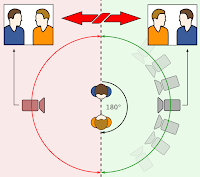Shot reverse shot or also known as shot/countershot is a film technique where one character is shown looking at another character (the other character is more than likely off-screen), and then the other character is shown looking back at the first character.
180 Degree Rule -

The 180 degree rule is a cinematography guideline that states that two characters in one scene should maintain the same left/right coordination to one another. When the camera passes over the invisible axis connecting the two subjects, it is called crossing the line and the shot becomes what is called a 'reverse angle'.
30 Degree Rule -

The 30-degree rule is a basic film editing guideline that states the camera should move at least 30 degrees relative to the subject between successive shots of the same subject.
Cut In -
In film a cut in shot is the interruption of a continuously filmed action by inserting a view of something else. It is usually, although not always, followed by a cut back to the first shot, when the cutaway avoids a jump cut. The shot is only on screen for no longer than 2-3 seconds.
Cross Cutting / Parallel Editing -
Cross-cutting is an editing technique most often used in films to establish action occurring at the same time, and usually in the same place. In a cross-cut, the camera will cut away from one action to another action, which can suggest the two actions are happening simultaneously. However it is not always the case.
Establishing Shot -
An establishing shot is usually the first shot of a new scene, designed to show the audience where the scene is taking place. It is usually an extreme wide shot.
Match On Action -
Or also known as 'Cutting on Action' is an editing technique or continuity editing in which one shot cuts to another shot portraying the action of the subject in the first shot. This creates the impression of a sense of continuity. The action carrying through creates a "visual bridge" which draws the viewers attention away from slight cutting continuity issues.
Temporal Overlap -
When an action is repeated from a different point of view.
Kuleshov effect -
A recognition that a shot’s meaning is not only dictated by what it contains, but by its relationship to other adjacent shots
Eisenstein Montage -
An approach to editing developed by filmmakers in the Soviet Union in the 20s. It emphasises dynamic, often discontinuous, relationships between shots and the juxtaposition of images. It’s primary focus was to engage with the viewer in an intellectual manner
No comments:
Post a Comment